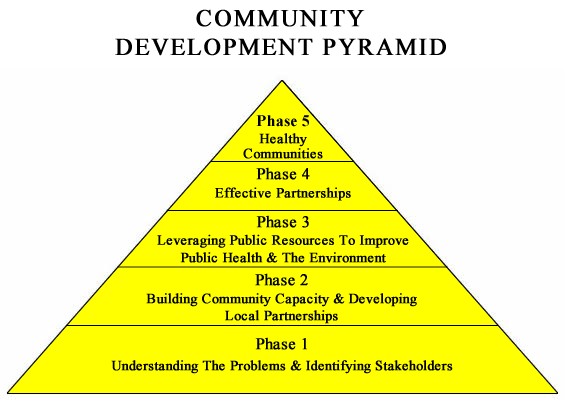Healthy Urban Communities in Massachusetts
Community Development Pyramid
Urban Environmental Infrastructure in Boston, MA Case Study:
Boston has always been a city full of neighborhood activism, so it was not difficult to find groups, issues or communities to work with. Many Boston neighborhoods launched community-based efforts to protect the urban environment, but were faced with many daunting obstacles. Federal, state and municipal environmental laws were numerous, confusing, and often not designed to meet resident needs. The legal and technical resources required to solve urban problems were nonexistent because mainstream environ-mental groups generally ignored inner city environmental issues and focused on wildlife habitat and ecosystem preservation. There was also little public education on the connections between the urban economy, environment and public health.
Click on each phase of the pyramid to examine the EPA's efforts to service community needs by developing a sustainable infrastructure so local stakeholders and residents have a forum to get information, raise their concerns, and access resources to improve the health and environmental quality in Boston neighborhoods.

Click each phase for additional information.
Partners
- Alternatives for Community and Environment
- Appalachian Mountain Club
- Ari Henta Hastings House
- Boston Public Health Commission
- Boston University, School of Public Health
- Center for Ecological Technology
- Chelsea Community Connection Coalition
- Chelsea Human Service Collaborative
- City of Boston, Department of Neighborhood Development
- City of Boston, Environmental Services Department
- City of Boston, Office of Sustainable Boston
- CityLife/Urban Vida
- Coalition to Protect Chinatown
- Committee for Boston Public Housing
- Dimlock, Codman Square, South Boston and Bowdoin Street Health Centers
- Dudley Street Neighborhood Program
- Eagle Eye Institute
- Earthworks
- East Boston - Chelsea Creek Action Group
- East Boston Ecumenical Community Committee
- East Boston Recreation, Master Planning, Advisory Council
- Environmental Diversity Forum
- Environmental League of Massachusetts
- Executive Office of Environmental Affairs
- Freedom House
- Garden Futures
- Greater Boston Environmental Justice Network
- Greenroots
- Groundwork Lawrence
- Lowell Parks and Conservation Trust, Inc.
- MainSouth CDC
- Massachusetts Bays Program
- Massachusetts Coalition for Occupational Safety
- Massachusetts Coastal Zone Management Program
- Massachusetts Department of Conservation and Recreation - Forest Service
- Massachusetts Department of Environmental Protection
- Massachusetts Department of Fisheries, Wildlife and Environmental Law Enforcement Riverways Programs
- Massachusetts Department of Food and Agriculture
- Massachusetts Department of Public Health
- Massachusetts Environmental Collaborative
- Massachusetts Facilities Administrators Association
- Massachusetts Public Health Association
- Merrimack River Watershed Council
- Metropolitan Area Planning Council
- National Center for Healthy Housing
- NELCC
- NESCAUM
- Neighborhood of Affordable Housing
- Neighborhood Planning Association of Back Bay
- Neighborhoods Against Urban Pollution
- Neponset River Watershed Association
- Neustras Raices, Inc
- New Ecology, Inc
- Notifications of Oil or Hazardous Substances Database
- Reaching Out to Chelsea Adolescents
- Regional Environmental Council
- Revision House
- Roxbury Community College Center for Environmental Education
- Roxbury Environmental Empowerment Program
- Save the Harbor/Save the Bay
- Second Nature
- Smart Growth
- STRIVE
- Suffolk County Conservation
- Tellus Institute
- The Food Project
- Toxics Action Center
- Tufts University
- University of Massachusetts, Urban Harbors Institute
- Urban Ecology Institute
- Urban Revival, Inc.
- US Department of Agriculture
- US Department of Health and Human Services
- US Department of Housing and Urban Development
- WalkBoston
- Worcester Roots Project
